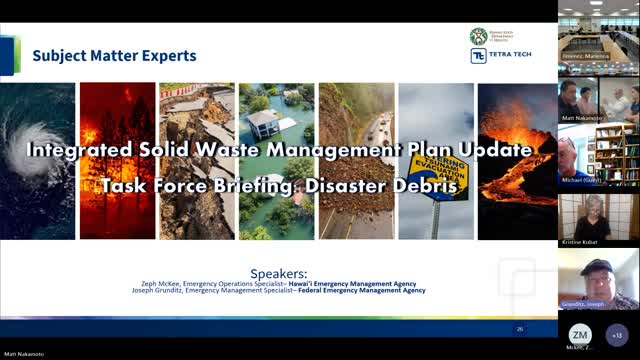Hawaii faces billion dollar challenge in storm debris cleanup
August 09, 2024 | Health, Executive , Hawaii

This article was created by AI summarizing key points discussed. AI makes mistakes, so for full details and context, please refer to the video of the full meeting. Please report any errors so we can fix them. Report an error »

In a recent government meeting, officials discussed the significant challenges posed by last year's tropical storm, which impacted four Hawaiian Islands and generated an estimated 1.2 million cubic yards of debris. The meeting focused on the state's response strategies, including how state assets would be deployed and how county debris removal plans would align with the expectations of the Hawaii Emergency Management Agency (HIEMA).
Participants emphasized the importance of effective debris waste stream management, highlighting the need for different approaches based on the unique circumstances of each island. For instance, Honolulu's high power plant necessitates a distinct strategy compared to those required for Hawaii Island or Maui. The discussions aimed to identify shortfalls in current plans and determine where federal funding might be necessary to support debris removal efforts.
The meeting also addressed the logistical challenges of managing such a large-scale debris removal project, estimated at around $1 billion. Officials noted that it would be unrealistic for Maui, with a population of approximately 180,000, to independently finance the cleanup efforts resulting from the wildfires. The collaborative approach discussed in the meeting aims to ensure that all counties are prepared to handle the aftermath of future disasters effectively.
Participants emphasized the importance of effective debris waste stream management, highlighting the need for different approaches based on the unique circumstances of each island. For instance, Honolulu's high power plant necessitates a distinct strategy compared to those required for Hawaii Island or Maui. The discussions aimed to identify shortfalls in current plans and determine where federal funding might be necessary to support debris removal efforts.
The meeting also addressed the logistical challenges of managing such a large-scale debris removal project, estimated at around $1 billion. Officials noted that it would be unrealistic for Maui, with a population of approximately 180,000, to independently finance the cleanup efforts resulting from the wildfires. The collaborative approach discussed in the meeting aims to ensure that all counties are prepared to handle the aftermath of future disasters effectively.
View full meeting
This article is based on a recent meeting—watch the full video and explore the complete transcript for deeper insights into the discussion.
View full meeting
